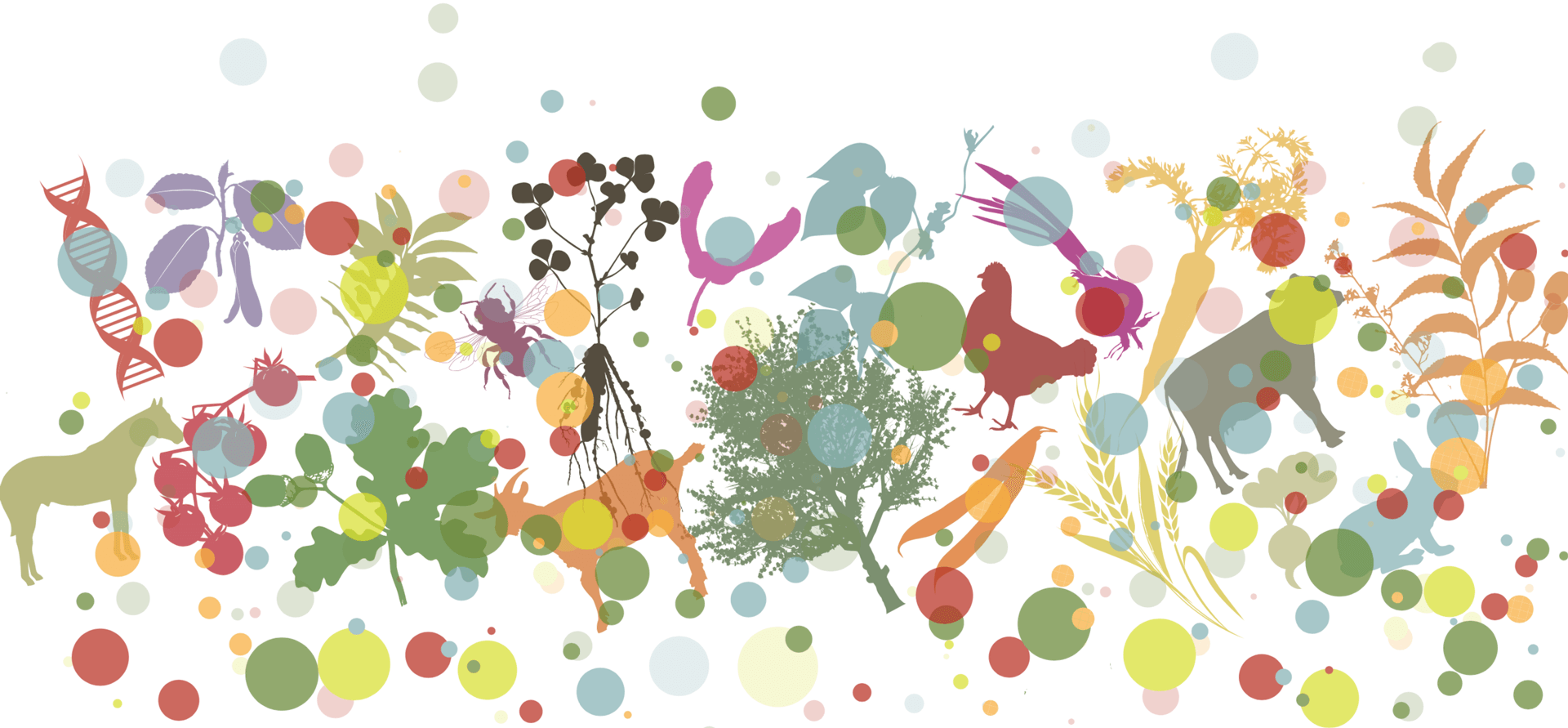A public mid-density genotyping platform for alfalfa (Medicago sativa L.)
Main Article Content
Abstract
Small public breeding programmes have many barriers to adopting technology, particularly creating and using genetic marker panels for genomic-based decisions in selection. Here we report the creation of a DArTag panel of 3,000 loci distributed across the alfalfa (Medicago sativa L.) genome for use in molecular breeding and genomic insight. The creation of this marker panel brings cost-effective and rapid genotyping capabilities to alfalfa breeding programmes. The open access provided by this platform will allow genetic data sets generated on the marker panel to be compared and joined across projects, institutions and countries. This genotyping resource has the power to make routine genotyping a reality for any breeder of alfalfa.
Article Details

This work is licensed under a Creative Commons Attribution 4.0 International License.
Authors retain copyright of the articles published in Genetic Resources and grant the journal right of first publication with open access. All articles published in Genetic Resource are licensed under Creative Commons Attribution 4.0 International License (CC BY 4.0) that allows others to download, share and adapt the work for commercial and non-commercial purposes as long as proper attribution to the original article is given. Genetic Resources permits and encourages authors to post items submitted to the journal (including the publisher's final layout) on personal websites or institutional repositories after acceptance and/or publication, while providing bibliographic details that credit their publication in Genetic Resources.
Blyton, M D J et al. (2023). “A new genetic method for diet determination from faeces that provides species level resolution in the koala”. bioRxiv 2023.02.12.528172. DOI: https://doi.org/10.1101/2023.02.12.528172. DOI: https://doi.org/10.1101/2023.02.12.528172
Bolger, A M, M Lohse, and B Usadel (2014). “Trimmomatic: a flexible trimmer for Illumina sequence data”. Bioinform 30(15), pp. 2144–2120. DOI: https://doi.org/10.1093/bioinformatics/btu170. DOI: https://doi.org/10.1093/bioinformatics/btu170
Chen, H et al. (2020). “Allele-aware chromosome-level genome assembly and efficient transgene-free genome editing for the autotetraploid cultivated alfalfa”. Nature Comm 11, pp. 1–11. DOI: https://doi.org/10.1038/s41467-020-16338-x. DOI: https://doi.org/10.1038/s41467-020-16338-x
Darrier, B et al. (2019). “A Comparison of Mainstream Genotyping Platforms for the Evaluation and Use of Barley Genetic Resources”. Front Plant Sci 10, pp. 1–14. DOI: https://doi.org/10.3389/fpls.2019.00544. DOI: https://doi.org/10.3389/fpls.2019.00544
Eathington, S R et al. (2007). “Molecular markers in a commercial breeding program”. Crop Sci 47, pp. 154–163. DOI: https://doi.org/10.2135/cropsci2007.04.0015IPBS. DOI: https://doi.org/10.2135/cropsci2007.04.0015IPBS
Fernandez, A L et al. (2019). Alfalfa, Wildlife, and the Environment. St. Paul, MN: National Alfalfa and Forage Alliance.
Ferrão, L F V et al. (2021). “Genomic Selection in an Outcrossing Autotetraploid Fruit Crop: Lessons From Blueberry Breeding”. Front Plant Sci 12, pp. 1–13. DOI: https://doi.org/10.3389/fpls.2021.676326. DOI: https://doi.org/10.3389/fpls.2021.676326
Feurerstein, U, A H D Brown, and J J Burdon (1990). “Linkage of Rust Resistance Genes from Wild Barley (Hordeum spotaneum) with Isozyme Markers”. Plant Breeding 104, pp. 318–324. DOI: https://doi.org/10.1111/j.1439-0523.1990.tb00442.x. DOI: https://doi.org/10.1111/j.1439-0523.1990.tb00442.x
Gerard, D et al. (2018). “Genotyping Polyploids from Messy Sequencing Data”. Genetics 210(3), pp. 789–807. DOI: https://doi.org/10.1534/genetics.118.301468. DOI: https://doi.org/10.1534/genetics.118.301468
Hasan, N et al. (2021). “Recent advancements in molecular marker-assisted selection and applications in plant breeding programmes”. J Genet Eng Biotech 19, pp. 1–26. DOI: https://doi.org/10.1186/s43141-021-00231-1. DOI: https://doi.org/10.1186/s43141-021-00231-1
Hawkins, C and L - X Yu (2018). “Recent progress in alfalfa (Medicago sativa L.) genomics and genomic selection”. The Crop Journal 6, pp. 565–575. DOI: https://doi.org/10.1016/j.cj.2018.01.006. DOI: https://doi.org/10.1016/j.cj.2018.01.006
Heffner, E L, M E Sorrells, and J - L Jannink (2009). “Genomic selection for crop improvement”. Crop Sci 49, pp. 1–12. DOI: https://doi.org/10.2135/cropsci2008.08.0512. DOI: https://doi.org/10.2135/cropsci2008.08.0512
Helentjaris, T et al. (1985). “Restriction fragment polymorphisms as probes for plant diversity and their development as tools for applied plant breeding”. Plant Mol Biol 5, pp. 109–118. DOI: https://doi.org/10.1007/BF00020093. DOI: https://doi.org/10.1007/BF00020093
Krishnakumar, S et al. (2008). “A comprehensive assay for targeted multiplex amplification of human DNA sequences”. PNAS 105(27), pp. 9296–9301. DOI: https://doi.org/10.1073/pnas.0803240105. DOI: https://doi.org/10.1073/pnas.0803240105
Li, H (2012). “Exploring single-sample SNP and INDEL calling with whole-genome de novo assembly”. Bioinform 28(14), pp. 1838–1882. DOI: https://doi.org/10.1093/bioinformatics/bts280. DOI: https://doi.org/10.1093/bioinformatics/bts280
Li, H (2013). “Aligning sequence reads, clones sequences and assembly contigs with BWA-MEM”. arXiv 1303.3997. DOI: https://doi.org/10.48550/arXiv.1303.3997.
Lorenzana, R and R Bernardo (2009). “Accuracy of genotypic value predictions for marker-based selection in biparental plant populations”. Theor Appl Genet 120, pp. 151–161. DOI: https://doi.org/10.1007/s00122-009-1166-3. DOI: https://doi.org/10.1007/s00122-009-1166-3
Mejia-Guerra, M K, D Zhao, and M J Sheehan (2021). “Genomic Resources for Breeding in Alfalfa: Availability, Utility, and Adoption”. In: The Alfalfa Genome, Compendium of Plant Genomes. Ed. by L X Yu and C Kole. Cham: Springer, pp. 177–189. DOI: https://doi.org/10.1007/978-3-030-74466-3_11. DOI: https://doi.org/10.1007/978-3-030-74466-3_11
Milner, S G et al. (2019). “Genebank genomics reveals the diversity of a global barley collection”. Nat. Genet 51, pp. 319–326. DOI: https://doi.org/10.1038/s41588-018-0266-x. DOI: https://doi.org/10.1038/s41588-018-0266-x
Mollinari, M and A A F Garcia (2019). “Linkage Analysis and Haplotype Phasing in Experimental Autopolyploid Populations with High Ploidy Level Using Hidden Markov Models”. Genes, Genomes, Genetics 3(10), pp. 3297–3314. DOI: https://doi.org/10.1534/g3.119.400378. DOI: https://doi.org/10.1534/g3.119.400378
Mollinari, M, B A Olukolu, et al. (2020). “Unraveling the Hexaploid Sweetpotato Inheritance Using Ultra-Dense Multilocus Mapping”. Genes, Genomes, Genetics 3(1), pp. 281–292. DOI: https://doi.org/10.1534/g3.119.400620. DOI: https://doi.org/10.1534/g3.119.400620
Putnam, D and E Meccage (2022). “Profitable alfalfa production sustains the environment”. In: Proceedings, 2022 World Alfalfa Congress, 14-17 November 2022, San Diego, CA. URL: https://alfalfasymposium.ucdavis.edu/+symposium/proceedings/2022/Articles/Daniel-Putnam-2022-Profitable-Alfalfa-Production-Sustains-The-Environment.pdf.
Tanksley, S D (1983). “Molecular markers in plant breeding”. Plant Mol Biol Rep 1, pp. 3–8. DOI: https://doi.org/10.1101/2023.02.12.528172. DOI: https://doi.org/10.1007/BF02680255
Telfer, E et al. (2019). “A high-density exome capture genotype-by-sequencing panel for forestry breeding in Pinus radiata”. PLoS One 14(9), pp. 222640–222640. DOI: https://doi.org/10.1371/journal.pone.0222640. DOI: https://doi.org/10.1371/journal.pone.0222640
Undersander, D (2021). “Economic importance, practical limitations to production, management, and breeding targets of alfalfa”. In: The Alfalfa Genome, Compendium of Plant Genomes. Ed. by L X Yu and C Kole. Cham: Springer, pp. 1–11. DOI: https://doi.org/10.1007/978-3-030-74466-3_1. DOI: https://doi.org/10.1007/978-3-030-74466-3_1
Wang, N et al. (2020). “Applications of genotyping-by-sequencing (GBS) in maize genetics and breeding”. Sci Rep 10. DOI: https://doi.org/10.1038/s41598-020-73321-8. DOI: https://doi.org/10.1038/s41598-020-73321-8







 This journal has been conceived as part of the
This journal has been conceived as part of the